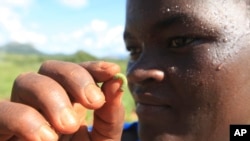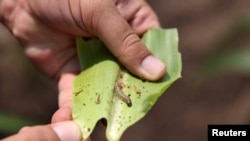A species of armyworm has spread to over 20 African countries and threatens Africa's main food crop -- maize.
The warning comes from the United States Agency for International Development, or USAID.
Joseph Huesing works as an advisor to USAID. He suspects the fall armyworms were transported to Africa from the American state of Florida or islands in the Caribbean.
Huesing says the insects are attacking maize crops -- also known as corn -- in African countries south of the Sahara desert.
"From Nigeria and Ghana, all the way to South Africa to Ethiopia,” he told VOA. “The most recent one is South Sudan, which reported fall armyworm infestation toward the end of June.”
Huesing thinks fall armyworms are a big threat to African agriculture. When they invade a maize field, he said, the insects can eat 30 percent or more of the crop. They also eat other crops.
A Challenge to Control
The fall armyworms got their name from fall, or autumn -- the time of year when they do the most damage in the northern United States. The first published report describing their presence in Africa appeared in early 2016. It suggested the insects had already been there for a year.
For several reasons, the fall armyworms may pose more problems for farmers than the African armyworm, which is native to Africa.
Fall armyworms can reproduce continuously under warm, moist conditions, says Yene Belayneh of USAID. He noted that they can feed off of more than 80 species in 27 plant families.
As adults, fall armyworms can fly up to 100 kilometers a day if pushed by winds. Some armyworms have found a ride on modern aircraft.
For this reason, Belayneh said, communication is especially important. “If there is an outbreak, for example in Ethiopia, alerting Sudan or Eritrea would be a wise thing,” he said.
In fact, the insects are in Ethiopia. The country's Plant Protection Directorate reported that as of July 10, fall armyworms have infested more than 440,000 hectares of crops. It said that about 305,000 hectares had been protected.
Harder to detect
But chemical treatments may be less effective with the new invaders than with the African armyworms. The fall armyworm enters “the plant and feeds from inside," says Belayneh. This makes the insect harder to recognize and harder to kill.
The species is defenseless in cold weather, but freezing conditions are rare in much of Africa.
Regina Eddy heads USAID's armyworm response team. She says her team’s goal is to provide training and technical choices. She identified Brazil as a model for fighting armyworms. A recent USAID report noted that Brazil spends an estimated $600 million each year to control the insects.
One control measure experts are taking is to more carefully inspect food arriving at African airports. The fall armyworms may have arrived on the continent through a food shipment from overseas.
The fall armyworm is not causing a crisis yet. But Belayneh told VOA no one is taking the situation lightly.
I’m Mario Ritter.
Sora Halake wrote this story for VOANews.com. George Grow adapted the story for Learning English. Mario Ritter was the editor.
______________________________________________________________
Words in This Story
species – n. a group of similar, animals, insects or plants
infestation – n. the act of spreading on or over (something) in a troublesome way
pose – v. to create; to ask
moist – adj. moderately wet
response – n. an act of answering or reacting to something
We want to hear from you. Write to us in the Comments Section.









